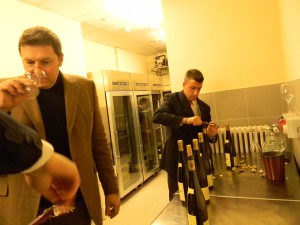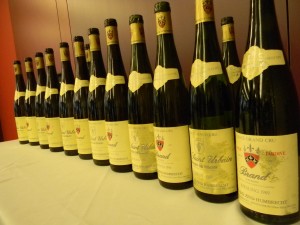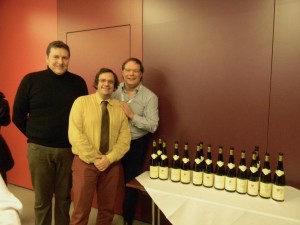Dynamic duo: A tale of two Zind Humbrecht Rieslings spanning over 20 years
December 1, 2012
Double vertical of Rangen and Brand Grand Cru Riesling from Zind Humbrecht / 11 November 2012
At the Merano Wine Festival in November 2012: Many thanks to project manager Ian d’Agata
What a great pleasure it was to be asked to comment the taste of each of the following 12 wines! I felt as if on a cloud, because I was able to understand what makes these two great Riesling so tasty. Olivier Humbrecht traveled to Merano to host the event, and Ian translated all of what was said into Italian.The domain was created in 1959 following the marriage of Leonard Humbrecht and Genevieve Zind. Leonard had already established an excellent reputation as a wine director, turning out many fine wines from various terroirs in Alsace. Their son is Olivier, the first Frenchman to qualify as a Master of Wine. He has taken the mantle with great skill.
The domain counts some 30 hectares. There is a commitment to low yields, but not absurdly so. At issue is an already very high limit for grands crus in Alsace: up to 70 hectoliters per hectare. The wines of Zind Humbrecht clock in at about half that amount.
The domain owns vines in four superb grand cru vineyards: Hengst, Goldert, Brand and Rangen.
Brand is legendary for its steep south/southeastern facing slopes, where there is much heat – hence the German word meaning “fire”. The soils are mainly granite and black mica. A silt like sand allows roots to travel down through to the fissures of the earth, which allows the vines protection from the driest microclimate in Alsace. Only Riesling is planted here by Zind Humbrecht – a precocious terroir.
The Rangen de Thann is the most southerly of Alsatian vineyards. From the Middle Ages, this terroir had become famous for producing wines of the best quality. The volcanic soil structure is unique: a mixture of volcanic rock and sedimentary sandstone, making up a layer of 40 to 60 centimeters above the fissured country rock, which allows the roots, here again, to penetrate deep into the earth. Low in clay content (15%), the soils are poor so the vine struggles to nourish itself – a good thing. Rangen is a late ripening vineyard, but its exceptional exposition allows the grapes to mature slowly into October and even early November, thus making it possible to achieve very high levels of concentration.

Checking the bottles before the master class with Olivier Humbrecht, the first French person to earn a Master of Wine
After tasting both wines, over a period of six vintages, I was just completely enamored by their quality. Usually, I like to rate wines according to the following rough scale. If the wine is in bold, I particularly like it. When red and bold, even more. When underlined as well, the very best. It is hard to make such gradations here because many of these wines I would just as soon put in red bold and underline… But given this premise, the reader can assume that all are just very good at least…
2008: The Rangen was beautifully subtle, with an elegance coming from an iodine freshness, matched with a lime and creamy lemon aspect. The attack is supple, with freshening acidity onto the mid palate, conveying an overall elegant feel. The finish is, again, subtle and sneaky. The Brand conveys more pear like aromas, white fruit, with a more evident richness on the mid palate – and a touch of licorice. This is more baritone in feel. Both are fine, but different.
2005: Here the Rangen has a more herbal component: hints of thyme and even some spiciness. There is a slightly dried fruit aspect on the nose. Is there just a bit of more evident botrytis here? The attack is brisk and the palate is dry, exuding greater freshness than the nose would perhaps suggest. 12.8 alcohol, with 4 grams of residual sugar. The Brand has a far more exotic fruit character on the nose – 14% alcohol, with close to 9 grams of residual sugar. I love the mango and blood red orange rind flavors. Just a touch of light petrol as well, with a fuller body than the Rangen – and a slightly warmer finish… Both 2005s are noticeably darker in color when compared to the 2008s.
2001: The Rangen seems to have a color that is slower in evolution when compared to the 2005, and the nose is quite subtle in its expression of white peach, white pepper. It has seamlessness on the palate that beguiles the taster – along with a very long and lingering finish. Very fine! The Brand is also excellent, but is more yellow peach as opposed to the white peach of the Rangen, with more evident richness marked by acacia aromas and flavors – along with fine white pepper as well. A pair of superb 2001s!
1994: Another marvelous pair! With about 6 grams of residual sugar. This was a challenging vintage: a winemakers vintage. Olivier managed very well. The nose of the Rangen was complex, combining a sweet citrus aspect, dry fruit, too, some “sweet” gunflint, grapefruit and potpourris. The aromas preceded a rich and enchanting palate that is balanced by excellent tonicity on the finish. I love a juicy fruit-filled aspect on the mid palate, before its precise finish. Lovely stuff. With twice as much residual sugar, I did not notice any excess sweetness in the Brand, which exuded a dew like floral aspect, acacia, more floral freshness and white pepper bordering on tobacco. The attack is frank and fresh – with an almost tannic aspect on a “serious” mid palate. Impressive in terms of underlying power, this Brand.
1990: This Rangen is quite subtle, with lime and salt notes, white floral elements, and pear. There is an almost viscous feel on the palate, but it remains thoroughly elegant – a good tension. The Brand is correctly tasted after, because it is far richer with more ample palate presence: peach, cinnamon spice and even a touch of hazelnut. This would go very well with veal in a creamy mushroom sauce!
1989: Wow, is all I could say about this next pair. I need to add a star or something because both are bold, red and underlined… Just when you thought it could not get better, it does. These two together were two of the best wines I have had side-by-side, ever. The Rangen* exudes a stony mineral aspect above all else, here, but also with subtle spice, freshness and pear, with an exuberant mid palate lift that makes this wine so exciting. The finish is very long with a tea like tonicity that keeps you on your toes. I was thinking of sea bass and a mousseline sauce for this one! And the Brand* matches the Rangen’s quality in its own manner: blood orange and a mix of spices with yellow peach enchant the nose, and the palate exudes exceptional balance with brisk acidity to match the opulence. The finish is lingering marked by a lovely note of quince. I could easily enjoy this with a roast chicken flavored with oranges or perhaps a homemade pumpkin soup? If anyone has either 1989 in their cellars, please invite me over. I’ll take care of the food.



It’s a shame you don’t have a donate button! I’d definitely donate to this outstanding blog! I guess for now i’ll settle for book-marking and adding your RSS feed to my Google account. I look forward to new updates and will share this site with my Facebook group. Talk soon!
[…] Double Vertical of Zind Humbrecht Rangen de Thann and Brand Riesling (6 vintages each) / Double Vertical of Taupenot Merme Charmes and Mazoyeres Chambertin (5 vintages each) / Vertical of Sassicaia / Vertical of Thanisch Berncasteler Doctor Riesling Auslese ranging from 1959 to 2011 / Vertical of St Michael-Eppan Sauvignon Blanc […]
[…] commentsDynamic duo: A tale of two Zind Humbrecht Rieslings spanning over 20 years – Connections to Wi… on Merano Wine Festival: From Sassicaia to superb Riesling, and so much moreMazoyeres and Charmes […]